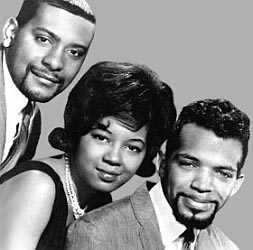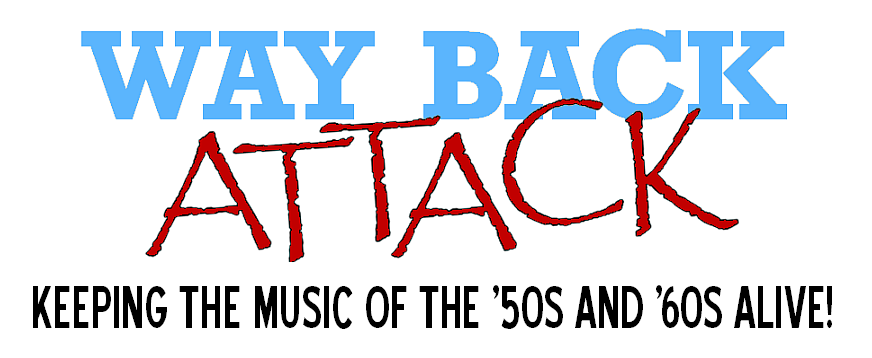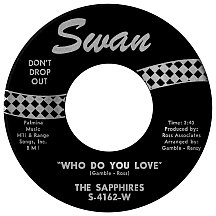THE SAPPHIRES
Who Do You Love
"Who Do You Love" is an easy-to-overlook gem. Squeezed in amid the girl group and soul hits of the era, this fabulously haunting ballad by The Sapphires received a reasonable share of airplay in early 1964 at the exact moment The Beatles were first welcomed into nearly everyone's homes via The Ed Sullivan Show, grabbing all the headlines while hogging a high percentage of airplay (logically so) on radio stations across the nation. When the Sapphires single peaked in the top 30 in March, the Liverpool Lads already had four hits in the top ten (including one on the same label), so a person could be excused for being so spectacularly sidetracked. Except once you've heard "Who Do You Love," it stays with you forever. Or at least it did for me. Later I sought out other records by the group, not realizing until later it was a woman with two men, a rare configuration, say, two years earlier but more common by '64 in the wake of the success of Ruby and the Romantics (with a lead lady and four guys), Gladys Knight and the Pips and The Essex (each with a one-three combination).
Jerry Ross, an up-and-coming songwriter-producer with at least one hit to his credit (The Dreamlovers' "When We Get Married" on his own Heritage record label), discovered the Philadelphia-born-and-bred trio. Carol Jackson was the lovely singer with the engaging vocal delivery; her groupmates, George Garner and Joe Livingston, presented themselves nicely, though ultimately were under-utilized. Swan Records, a Philly company in business several years, showed interest and Ross set about the task of getting the group into the studio; he called upon friend and fellow Philadelphian Kenny Gamble, barely out of his teens, to work with him. A bouncy Roland Smith song, "Where is Johnny Now," became the Sapphires' first single, receiving positive reviews in the trade magazines and making a brief chart appearance in the summer of 1963; Roland and Carol cowrote the flip side, "Your True Love."
Next up: "Who Do You Love," a Gamble-Ross tune arranged by Gamble with frequent collaborator Joe Renzetti (he liked being called "Renzy"). The song's success was encouraging but the follow-up, "I Found Out Too Late," misfired, perhaps because it was too similar to its predecessor. And how about those suspiciously female-sounding background singers? Turns out the producers wanted to go in more of a girl group direction by using another of their discoveries, The Swans, a studio-created act whose members' names seem to have faded from everyone's memory banks, for backing vocals. One single by the Swans had coincidentally been issued on the Swan label in '63; "He's Mine" could have been a hit if only the original version by Alice Wonder Land (real name: Alice Faye Henderson) hadn't (justifiably) gotten in the way. The Swans did put a record on the charts, though, at the same time as the Sapphires' biggest hit; "The Boy With the Beatle Hair," written by Gamble, Ross, Renzetti and Billy Jackson, came out on Cameo, timed to take advantage of the Fab Four's sudden popularity. After that, the Swans swam on over to the studio where Carol was making Sapphires masters, never to progress any further.

George and Joe did continue performing live with Carol and made at least some of the records with her. "Gotta Be More Than Friends" became the group's final single for Swan in the fall, though they had already signed with ABC-Paramount by that time. The larger company gave them a better contract with Ross, Gamble and Renzy still involved; stalwart studio arranger Jimmy Wisner added his two cents as well. "Hearts Are Made to Be Broken" was more of a solo Carol Jackson effort (though she never actually had a solo record). On the other hand, "Thank You For Loving Me" (written by Tommy Boyce, Bobby Hart and Wes Farrell) featured prominent backing vocals by Valerie Simpson and Melba Moore (Val's future hubby Nick Ashford also made contributions at the sessions), achieving a sonic similarity to recent Red Bird label hits (a la Dixie Cups and Jelly Beans). No sign of Garner or Livingston (I hope they at least got paid). The song, an infectious ode to romantic affection, managed a "Bubbling Under" Billboard ranking in the fall of '64.
"Gotta Have Your Love," a pleasurably breezy number composed by Tony Powers and Jack Keller, had a notable run on the Hot 100 and rhythm and blues charts in the spring of 1965. Gamble moved on to other projects (within a couple of years he was running his own Gamble record label) while Jerry Ross and "Joe Renzy" continued the formula of making Sapphires records without Carol's male bookends. "Evil One" was followed by "Gonna Be A Big Thing," which had appeared a few months earlier as a B side by ABC-Paramount girl group The Yum Yums (who then recorded as Honey and the Bees well into the 1970s). "The Slow Fizz," in early 1966, was a modernistic attempt at creating a dance craze; composed by Lori Burton and Pam Sawyer (the all-over-the-place songwriters who also made records as The Whyte Boots), its sound was far removed from the Sapphires of two years earlier.
When "Slow Fizz" fizzled, ABC dropped the group. All three original members left the music business, but unbeknownst to them a following developed, Carol Jackson in particular having many fans who consider her one of the best soulful songbirds of the 1960s. Jerry Ross made a name for himself at Mercury Records starting in 1966, writing and producing hits for Bobby Hebb, Jerry Butler, Keith, Spanky and Our Gang, Jay and the Techniques and others; he revived Heritage Records in '68 and later founded the hot early-'70s Colossus label. Kenny Gamble may not have realized it at the time, but The Sapphires were his entry into what became a hitmaking dynasty in the City of Brotherly Love. The Intruders helped establish his presence in the latter half of the '60s; with partners Leon Huff and Thom Bell, his Philadelphia International Records reinvented soul music in the 1970s, making stars of several acts (The O'Jays, Harold Melvin and the Blue Notes, Billy Paul and The Three Degrees) that had been around since his formative years of the early '60s.


